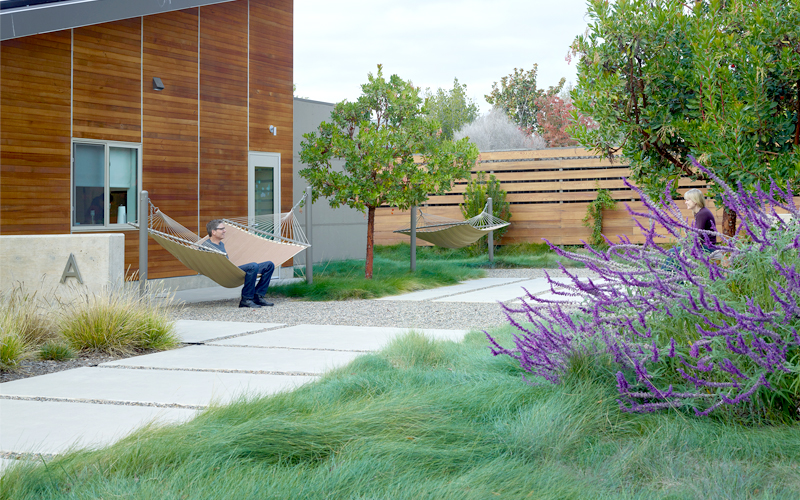Professional Practice
Using Low-Impact Materials: Sustainable Woods
 Lumber for fences and benches is FCS-certified. ASLA 2015 Professional Residential Design Honor Award. Sweetwater Spectrum Residential Community for Adults with Autism Spectrum Disorder, Sonoma, California / Roche + Roche Landscape Architecture.
Lumber for fences and benches is FCS-certified. ASLA 2015 Professional Residential Design Honor Award. Sweetwater Spectrum Residential Community for Adults with Autism Spectrum Disorder, Sonoma, California / Roche + Roche Landscape Architecture.Wood has a carbon footprint 75 percent less than common building materials, like concrete or steel, and can be a renewable, resource-efficient material in landscape design.
The Sustainable SITES Initiative™ (SITES®) recommends building with certified, sustainably-harvested woods, recycled woods, and recycled plastic or composite lumber to preserve forests, which are critical to sequestering green house gas (GHG) emissions, and extend the life of useful materials. Instead of using increasingly-scarce virgin woods, particularly from tropical hardwoods, homeowners can use reclaimed wood from existing structures and avoid sending that material to the landfill. Recycled wood can be salvaged from places like old buildings and shipping materials, and restored for a variety of residential uses, including decking, seating, and fences.
There is on-going debate over recycled plastic and composite lumber as a sustainable material. Composites are generally made of waste wood fibers and recycled plastics and can last over 20 years. However, these materials are difficult to dispose of because their production process binds recycled wood fibers with non-recyclable plastics, thereby merely delaying the material ending up in the landfill. Landscape architects should review the environmental product declarations and carbon footprint of wood and other materials before specifying for a site.
It is important that wood is sustainably sourced. Certified woods refer to harvested woods that originate from responsibly managed forests. These woods are certified through an independent organization that issues standards for sustainable forest management. Sustainable forest management enables lumber companies to harvest wood for materials while conserving forest ecosystems and preserving natural habitat. Sustainable forest management ensures a stable source of lumber and minimizes adverse environmental effects, such as soil erosion, stream sedimentation, water and air pollution, and waste production.
A few innovative firms are now fusing bamboo into durable hardwoods; thermally-modifying woods to make them harder and more disease-resistant; and producing modified polymerized and acetylated woods. In addition, there are a now a range of sustainable American hardwoods, like Black Locust.
Source: U.S. Green Building Council; Sustainable Deck Materials, Green Living
Organizations
Forest Stewardship Council
PEFC Council
Rainforest Alliance
Sustainable Forestry Initiative
Resources
How to Buy Good Wood, Natural Resources Defense Council
Green Wood: Building Green with Wood, Ken Bland, Structure Magazine, 2005
Increasing the Durability of Softwoods to Reduce Use of Tropical Hardwoods, The Dirt, American Society of Landscape Architects
Why Use Ipe When You Can Use Black Locust?, The Dirt, American Society of Landscape Architects
SITES Aims to Transform the Marketplace, The Dirt, American Society of Landscape Architects
Know the Forest and the Trees: A Consumer’s Guide to Buying Wood, National Resource Defense Council
Frequently Asked Questions About LEED Credit Achievement and FSC Certified Material, Forest Stewardship Council
Use Certified Wood, Landscape for Life
Guide to Sustainable Decking Materials, Green Living Ideas
Research
"Sustainable Procurement of Wood and Paper-based Products," World Resources Institute and World Business Council on Sustainable Development (WBCSD). June, 2009
“Wood as a Sustainable Building Material,” Paul H. Falk, Forest Products Journal, 2009
Projects
Sweetwater Spectrum Residential, Sonoma, California
Roche + Roche Landscape Architecture
Drs. Julian and Raye Richardson Apartments, San Francisco
Andrea Cochran Landscape Architecture
300 Ivy, San Francisco, California
Fletcher Studio